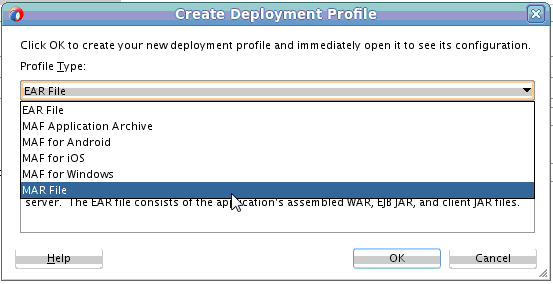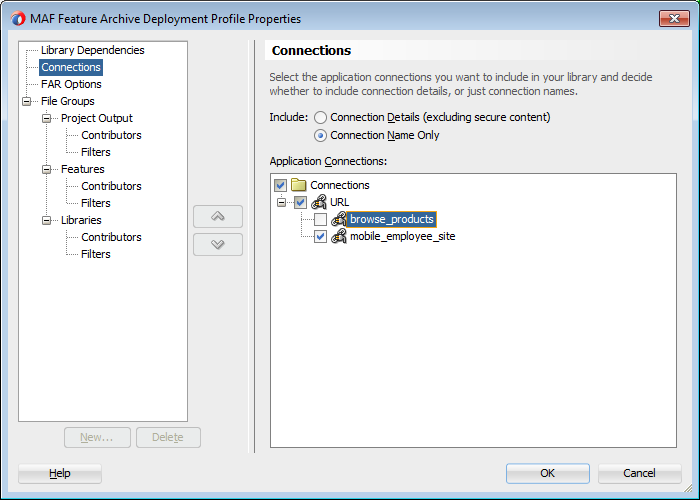25 Deploying MAF Applications
This chapter includes the following sections:
25.1 Introduction to Deployment of MAF Applications
Before you can publish an application for distribution to end users, you must test it on a device or virtual device to assess its behavior and ease of use. MAF provides ready-to-use deployment profiles for each platform to facilitate deployment of your MAF application.
Use the ready-to-use deployment profile or create your own to deploy your MAF application to the device or virtual device (emulator or simulator) where you want to test your MAF application.
MAF uses the deployment profile to execute the deployment of an application by copying a platform-specific template application to a temporary location, updating that application with the code, resources, and configuration defined in the MAF project. MAF then builds and deploys the application using the tools of the target platform. You can deploy a mobile application as the platform-specific package which you can make available from a download site or application marketplace (for example, the Apple App Store). For testing and debugging, you can deploy to a device or virtual device. You can reuse the application features by deploying the view controller projects as a feature archive (FAR). You also have the option to reuse the entire mobile application by deploying it as a Mobile Application Archive (.maa) file.
Each MAF deployment profile (Android, iOS, Windows) includes a set of different libraries that are specific to the type of deployment (release or debug) in combination with the deployment target (simulators or actual devices). In addition, each set of these libraries includes a JVM JAR file. The application binding layer resides within this virtual machine, which is a collection of Objective-C libraries. For example, MAF deploys a JVM JAR file and a set of libraries for a debug deployment targeted at an iOS simulator, but deploys a different JVM JAR file and set of libraries to a debug deployment targeted to an actual iOS-powered device. The libraries that you declare for the project are included in the deployment artifacts for the project.
We recommend that you invoke JDeveloper’s Build > Clean All command in a number of scenarios prior to deploying your application so that JDeveloper removes artifacts and settings left over from previous builds in order to begin a fresh build process. These scenarios are:
-
Changes to deployment profile settings, such as build mode or application name.
-
Adding or removing a Cordova plugin.
-
Changes to preferences for the Android platform, such as Gradle proxy settings, Android SDK location, or signing credentials.
25.2 Working with Deployment Profiles
For MAF application deployment, you can either create a ready-to-use deployment profile or use a customized deployment profile. A deployment profile defines how an application is packaged into the archive that will be deployed to the platform-specific device or virtual device.
You deploy a MAF application to the platform that you want your application to run on using a deployment profile. MAF provides a ready-to-use deployment profile for each platform that it supports (Android, iOS, Windows) or you can create a customized deployment profile. A deployment profile defines how an application is packaged into the archive that will be deployed to the platform device (for example, an Android-powered device or Android emulators). The deployment profile does the following:
-
Specifies the format and contents of the archive.
-
Lists the source files, deployment descriptors, and other auxiliary files that will be packaged into the archive file.
-
Describes the type and name of the archive file to be created.
-
Highlights dependency information, platform-specific instructions, and other information.
In addition to the platform-specific deployment profiles, MAF also provides a deployment profile that enables you to package the MAF application as a MAF Application Archive (.maa) file. Using this file, you can create a new MAF application using a pre-existing application that has been packaged as an .maa file. By default, this deployment file bears the name of the MAF application followed by _archive. See Creating a Mobile Application Archive File.
25.2.1 About Automatically Generated Deployment Profiles
When an application is created, MAF generates a set of deployment profiles with default settings and image files. Use the Deploy option from the Application menu to use a profile to deploy the application.
MAF generates deployment profiles that are seeded with default settings and image files when you create an application. Provided that you have configured the environment correctly, you can use these profiles to deploy a MAF application immediately after creating it by choosing Application and then Deploy, as shown in Figure 25-1.
Figure 25-1 Default Deployment Profiles
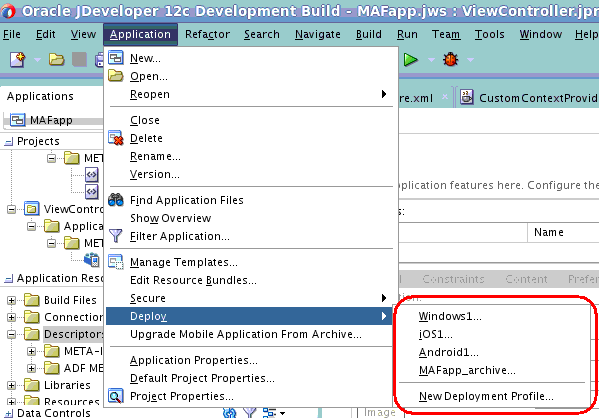
Using the Deployment Action page, shown in Figure 25-2, you then select the appropriate deployment target.
Figure 25-2 Selecting a Deployment Target
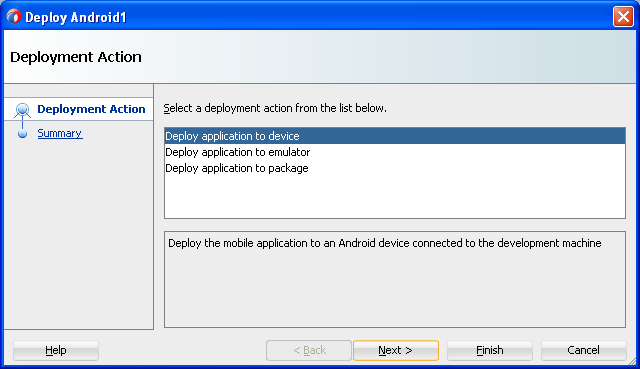
Each deployment profile has distinct environment set up and configuration requirements. See:
You can accept the default values used for these profiles, or edit them by selecting the profile from the Deployment page of the Application Properties dialog and then clicking Edit. Figure 25-3 illustrates the Android Options page for a default Android application profile.
Figure 25-3 Editing a Default Deployment Profile

MAF packages the application and view controller projects as separate Feature Archive (FAR) files. These JAR files of MAF files are used as resources for other applications and are described in Deploying Feature Archive Files (FARs). Because MAF creates these FAR files as dependencies to the MAF application profile, you can include or exclude them using the Profile Dependencies page of the Application Properties dialog, shown in Figure 25-4.
Note:
The application controller project must contain a single FAR profile dependency; otherwise, the deployment will fail.
Figure 25-4 Editing FAR Contents from MAF Projects
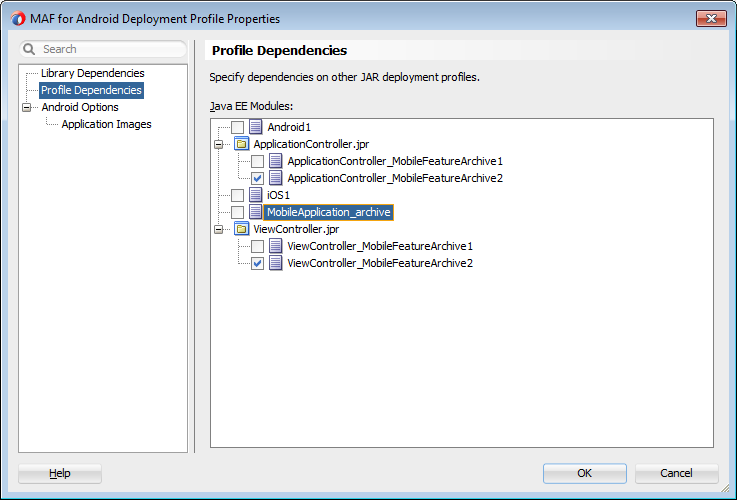
Using the File Groups-related pages of the Project Properties dialog, you can customize the contents of the view controller FAR file, as shown in Figure 25-5. For more information on the Project Properties dialog, see the Oracle JDeveloper online help and also the Configuring Deployment Profiles in Developing Applications with Oracle JDeveloper.
Figure 25-5 Editing the FAR of the View Controller Project
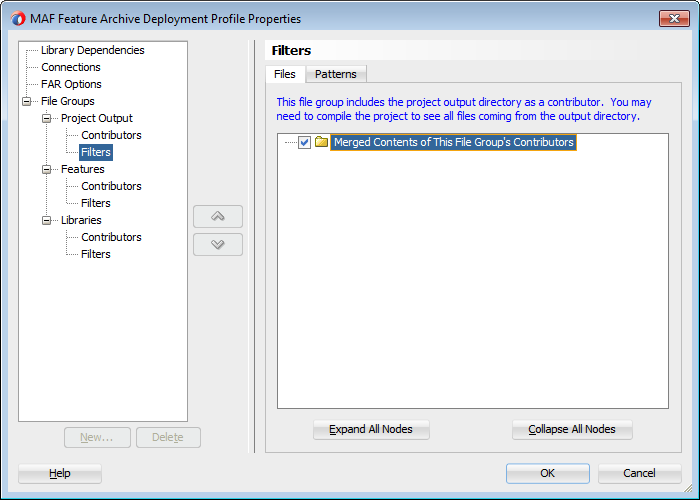
For more information on editing deployment profiles using the Application Properties dialog pages, see Viewing and Changing Deployment Profile Properties in Developing Applications with Oracle JDeveloper and the Oracle JDeveloper online help for the Application Properties and Project Properties dialogs.
25.2.2 How to Create a Deployment Profile
After designating the SDKs for the target platforms, follow the steps in the task to use Create Deployment Profile to create deployment profiles. Although you can create multiple deployment profiles, an application needs only one application-level deployment profile for deployment.
MAF creates a set of deployment profiles when you create a mobile application. You can deploy an application using these profiles, edit them, or construct new ones using the MAF-specific deployment profile pages. The Create Deployment Profile wizard, shown in Figure 25-6, enables you to create a default deployment profile from these pages. You can create as many deployment profiles as needed. For more information on these standard deployment profile pages, click Help to see the JDeveloper online help.
Note:
MAF application deployment only requires the creation of an application-level deployment profile; you do not have to create a view controller-level deployment profile.
Before you begin:
To enable JDeveloper to deploy mobile applications, you must designate the SDKs for the target platforms as described in Configuring the Development Environment for Platforms and Form Factors in Installing Oracle Mobile Application Framework.
Tip:
For iOS deployments, run iTunes and the iOS Simulator at least once before you configure their directory locations.
To create a deployment profile:
25.2.3 What Happens When You Create a Deployment Profile
After you complete the Create Deployment Profile wizard, JDeveloper creates a deployment profile and opens the Deployment Profile Properties editor. When an application is deployed, JDeveloper creates a deployment directory and the related subdirectory in addition to FAR files for the default projects.
After you complete the wizard, JDeveloper creates a deployment profile and opens the Deployment Profile Properties editor.
Table 25-1 lists the MAF-specific pages in the Deployment Profile Properties editor, shown in Table 25-1.
Table 25-1 MAF-Specific Deployment Profile Pages
| Page | Function |
|---|---|
|
iOS Options |
Enables you to modify the settings for an application to be deployed on an iOS-powered device or iOS simulator. |
|
Android Options |
Enables you to modify the settings for an application deployed to an Android-powered device or Android emulator. |
|
Windows Options |
Enables you to modify the settings for an application that you deploy to the Universal Windows Platform. |
|
Application Images |
Enables you to assign custom icons to an application by adding the appropriate graphics file. |
|
Device Orientations |
Enables you to restrict the display of an application to certain device orientations. This page is used only for iOS deployment profiles. |
Note:
Deployment depends on the needs of your application. You can deploy an application using the default values seeded in the pages listed in Table 25-1.
When you deploy an application, JDeveloper creates a deployment directory and related subdirectory. It also creates Feature Archive files (FARs) for the view controller projects (which must have different names) and application controller project. In addition to these two FARs, JDeveloper creates copies of any FARs that were imported into the project. Changes to the compilation profiles require the removal of the deployment directory. You can remove this directory, as well as the deployment directory within the view controller project that contains the FAR, by selecting Build and then Clean All.
25.3 Deploying a MAF Application to the Android Platform
MAF applications can be deployed to an Android device, an emulator, or to a deployment package that you or end users then use to install the application on an Android device or emulator.
MAF provides two build modes for an application that you deploy to the Android platform. Use debug mode to test and debug your application as you go through the development cycle. Use release mode to deploy an application that is release ready and can be published to end users through an application marketplace, such as Google Play.
MAF provides a ready-to-use deployment profile (Android1) that deploys your MAF application. You can use this ready-to-use deployment profile or create one or more other deployment profiles to deploy your MAF application to the Android platform. Using a deployment profile, you can deploy your MAF application in debug mode or release mode.
Creating a new deployment profile or editing an existing profile, you can:
-
Specify additional library and profile dependencies for your application
-
Choose between debug or release build modes
-
Specify options such as the application name and version
-
Specify the images that the application uses to render its logo in the splash screen and the icon that appears on the user’s device.
-
Specify the preferred storage location for the MAF application when installed on the Android device.
-
Choose the logging level for the Gradle build tool that MAF uses to build the MAF application. For information about these log levels, see Gradle’s documentation.
-
Specify the minimum SDK API level that determines the minimum version of Android your MAF application can run on.
For more information about how to edit or create a deployment profile, see Working with Deployment Profiles. Click Help in the deployment profile dialogs to view information about the respective tasks that you can perform in each dialog.
Before you deploy a MAF application using a deployment profile, you download the Android SDK and reference it from the Android Platform dialog in MAF Preferences, as described in Configuring the Development Environment for Target Platforms and How to Install the Android SDK in Installing Oracle Mobile Application Framework.
MAF uses Gradle to build and deploy MAF applications to the Android platform. MAF downloads and installs the Gradle build tool the first time that you deploy a MAF application. If your development machine is located behind a corporate firewall, configure the Gradle proxy settings so that MAF can successfully download, install, and configure Gradle. See How to Configure Gradle Proxy Settings.
After you finish development of your MAF application, you can publish it to an application marketplace, such as Google Play. Before you publish the application, make sure that the build mode in the deployment profile you use to deploy the application is in release mode, as shown by Figure 25-7. You access the Android Options dialog from JDeveloper’s Application > Application Properties > Deployment menu. To deploy in release mode, you also need to sign the application, as described in How to Sign a MAF Application that You Deploy to the Android Platform.
For information about publishing an application to Google Play, see http://developer.android.com/tools/publishing/publishing_overview.html.
Figure 25-7 Release Mode in Deployment Profile Properties
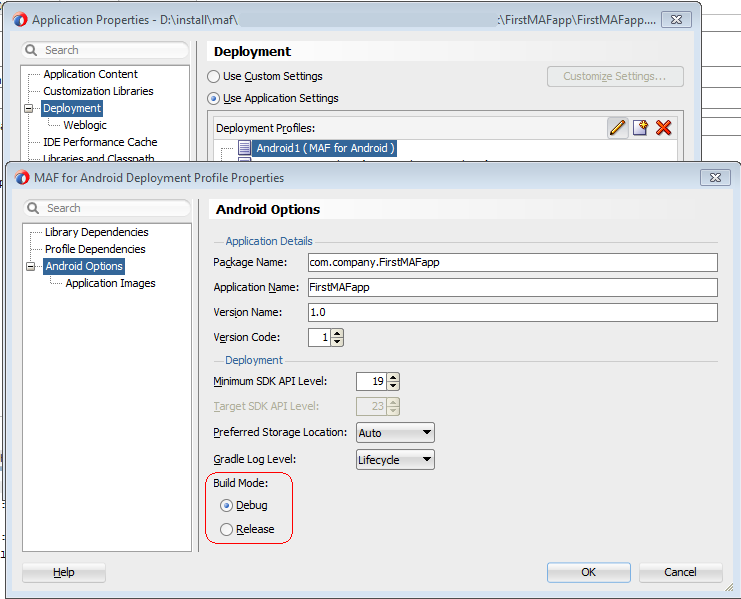
25.3.1 How to Configure Gradle Proxy Settings
If your computer is in a corporate network, configure proxy settings in the Gradle Proxy Settings dialog so that MAF can download and install the Gradle tools required to build MAF applications that you deploy to the Android platform.
To configure Gradle proxy settings:
-
In JDeveloper, click Tools, Preferences, Mobile Application Framework, Android Platform, and Gradle Proxy Settings to open the dialog shown in Figure 25-8.
Figure 25-8 Gradle Proxy Settings
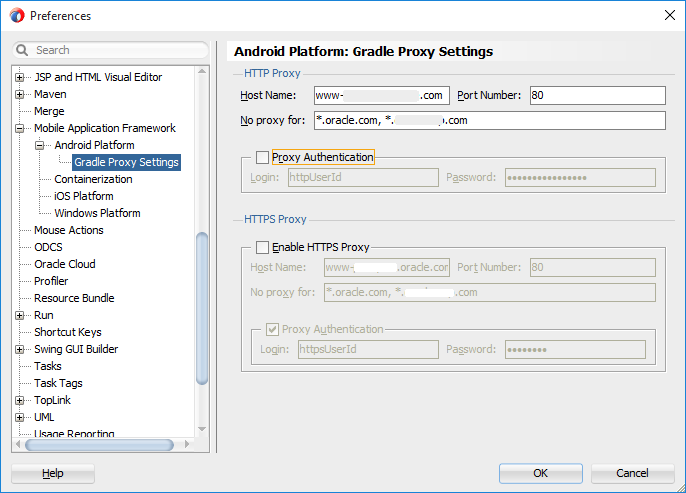
-
As necessary, complete the fields in the HTTP Proxy and HTTPS Proxy sections of the dialog:
-
Host Name: Enter the URI of the proxy server.
-
Port Number: Enter the port number that the proxy server uses.
-
No proxy for: Enter a | delimited list of URIs to ignore. For example,
*.nonproxyrepos.com|*.oracle.com|localhost. -
Proxy Authentication: Select if the proxy server requires authentication credentials and enter these credentials in the Login and Password fields.
-
Enable HTTPS Proxy: Select if you need to specify details (host name, port number, and so on) for a HTTPS Proxy server. This makes the subsequent input fields writable.
-
-
Click OK.
25.3.2 How to Sign a MAF Application that You Deploy to the Android Platform
An application must be signed before it can be deployed to an Android device or emulator. Android does not require a certificate authority; an application can instead be self-signed.
Defining how the deployment signs a MAF application is a two-step process: within the Android Platform page of the MAF preferences, you first define debug and release properties for a key that is used to sign Android applications. You only need to configure the debug and release signing properties once. After you define these options, you configure the deployment profile to designate if the application should be deployed in the debug or release mode.
If no keystore file exists, you can create one using the keytool utility, as illustrated in the following example.
keytool -genkeypair
-v
-keystore c:\jdeveloper\mywork\releasesigning.keystore
-alias releaseKeyAlias
-keyalg RSA
-keysize 2048
-validity 10000
In this example, the keystore contains a single key, valid for 10,000 days. As described in the Signing Your Applications document, available from the Android Developers website (http://developer.android.com/tools/publishing/app-signing.html), the keytool prompts you to provide passwords for the keystore and key, and to provide the Distinguished Name fields for your key before it generates the keystore. Refer to Java SE Technical Documentation (http://download.oracle.com/javase/index.html) for information on how to use the keytool utility.
To configure the key options for the debug mode:
-
Click Tools, then Preferences, and then Mobile Application Framework.
-
Select Android Platform and, in the Signing Credentials section, enter a password used by the deployment to create a keystore file and key needed for a debug deployment in the Key and Keystore Password field. This password, which generates a keystore and keyfile for deployment to an Android-powered device or emulator, can be any value, but must be at least six characters long. The default password is Android.
To configure the key options for the release mode:
-
Click Tools, Preferences, and Mobile Application Framework.
-
Select Android Platform, then the Release tab, and then define the following:
-
Keystore Location—Enter, or browse to and retrieve, the directory of the keystore containing the private key used for signing the application for distribution.
-
Keystore Password—Enter the password for the keystore. This password allows access to the physical file.
-
Key Alias—Enter an alias for the key. This is the value set for the keytool's
-aliasargument. Only the first eight characters of the alias are used. -
Key Password—Enter the password for the key. This password allows access to the key (identified by the alias) within the keystore.
Tip:
Enter the password and key password requested by the keytool utility before it generates the keystore.
-
-
Click OK.
25.3.3 What You May Need to Know About Credential Storage
MAF stores passwords for the key and keystore in the file-based credential store, cwallet.sso. This file, which manages credential storage and retrieval, is located within the o.maf folder in the user's JDeveloper system folder.
For example, in a Windows environment, the cwallet.sso file is located at C:\Users\jsmith\AppData\Roaming\JDeveloper\system12.1.3\o.maf.
See About Oracle Wallet in Administering Oracle Fusion Middleware.
Note:
MAF stores the key and keystore credentials in a file called product-preferences.xml. MAF migrates these credentials to the cwallet.sso file if you preserve the preference settings by clicking Yes in the Confirm Import Preferences dialog during the installation process of the current version of JDeveloper and MAF. However, the cwallet.sso file is not migrated to other installations of the current version of Oracle JDeveloper with MAF. If you reinstall (or create a separate installation), you must either copy the cwallet.sso file to the o.maf folder or reconfigure the release mode credentials in the Platforms preferences page.
25.3.4 How to Deploy a MAF Application to the Android Platform
Deploy the application to the Android platform using a MAF for Android deployment profile.
To deploy a MAF application to the Android platform:
-
Select Applications, then Deploy, then select an Android deployment profile.
-
Select the appropriate deployment option from the list in the dialog that appears:
-
Deploy application to device
Before you select this option that deploys directly to an Android-powered device, connect the device to the development computer that hosts JDeveloper, set the device to developer mode, and turn on USB debugging. For more information about these tasks, see How to Set Up an Android-Powered Device in Installing Oracle Mobile Application Framework.
-
Deploy application to emulator
Before you select this option that deploys directly to an Android emulator, set up and start the Android emulator. For more information about this task, see How to Set Up an Android Emulator in Installing Oracle Mobile Application Framework.
-
Deploy application to package
Deploys the MAF application to an .APK file that you can then distribute for installation on an Android device or emulator.
-
-
Review the Summary page and click Finish.
25.3.5 What Happens When You Deploy a MAF Application to the Android Platform
MAF generates an .APK file that it uses to install the MAF application on a device or emulator if either of these deployment options were chosen. If you chose the deploy application to package option, navigate to the directory where MAF generated the .APK file to retrieve it.
MAF includes the following in the .APK file.
-
The content in the
adfmsrc -
The content in the
.adffolder -
maf-application.xmlandmaf-feature.xmlfiles -
logging.propertiesfile -
The JVM files
For deployment to device or emulator options, MAF installs and launches the MAF application. If you deployed the MAF application in debug mode, a red icon appears on each screen of the MAF application, as shown in the upper-left portion of Figure 25-9. MAF applications that you deploy in release mode do not render this icon.
Figure 25-9 MAF Application Deployed in Debug Mode
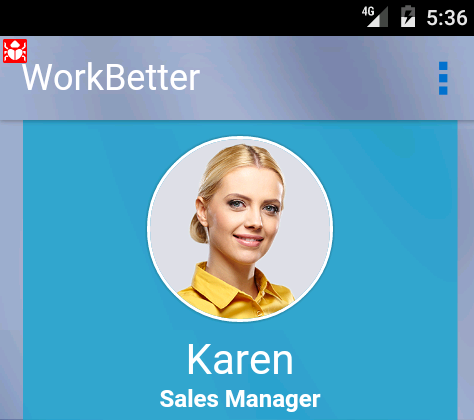
MAF uses the Android Debug Bridge to connect to the device or emulator where you want to deploy the MAF application. If the deployment does not detect a device, it restarts the Android Debug Bridge server five times until it detects a device (if deploying to a device) or emulator (if deploying to an Android emulator). If it detects neither, then it ends the deployment process, as shown in Figure 25-10.
Figure 25-10 Deployment Terminated
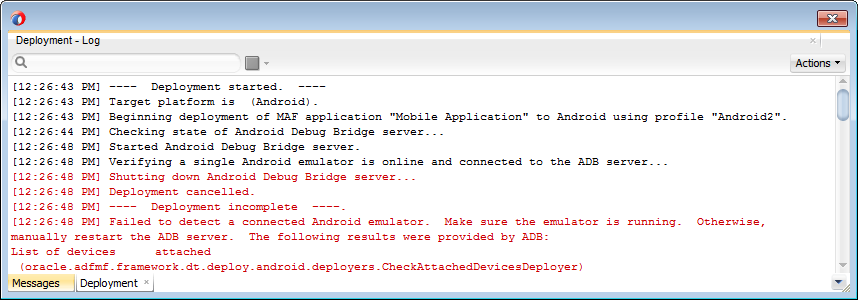
If you are using the Android Debug Bridge command line tool prior to deployment, then you must enter the same command again after the deployment has completed. For example, if you entered adb logcat to view logging information for an emulator or device prior to deployment, you would have to enter adb logcat again after the application has been deployed to resume the retrieval of the logging output. For more information about the Android Debug Bridge command line tool, which is located within (and executed from) the platform-tools directory of the Android SDK installation, refer to the Android Developers website (http://developer.android.com/tools/help/adb.html).
After you select a deployment action, JDeveloper creates a shortcut on the Deploy menu that enables you to easily redeploy the application using that same deployment action.
By default, MAF applications are installed on an Android-powered device's internal storage after they have been deployed from JDeveloper to a device, or downloaded from an application marketplace, such as Google Play. The following options, which are available from the Preferred Storage Location dropdown list, enable you to specify a preferred storage location for the MAF application.
-
Internal—Forces the MAF application to be installed on the device's internal storage.
-
External—Allows the application to be installed on the device's SD card. However, if the Android system determines that the application cannot be installed on the SD card (for example, no SD card has been mounted, or the SD card exists but has insufficient space), then it installs the application on the device's internal storage instead. The mobile device user can move the application between internal and external storage using the system settings.
-
Auto—Specifies that the application may be installed on the device's external or internal storage. The mobile device user can move the application between internal and external storage using the system settings.
Selecting the External or Auto options enables the deployment framework to update the <manifest> element in the AndroidManifest.xml file with an android:installLocation attribute and a value of "preferExternal" or "auto". Populating the AndroidManifest.xml file with this attribute enables MAF applications to be stored on an external SD card or internal storage. For more information, see the "App Install Location" chapter in Data Storage Guide, available from the Android Developers website (http://developer.android.com/guide/topics/data/install-location.html) or from the Android SDK documentation.
25.3.6 How to Add a Custom Image to an Android Application
Enabling MAF application icons to display properly on Android-powered devices of different sizes and resolutions requires low, medium, high, extra-high, extra-extra-high density, and extra-extra-extra-high density versions of the same images. MAF provides default Oracle images that fulfill these display requirements.
However, if the application requires custom icons, you can use the Application Images page, shown in Figure 25-11, to override default images by selecting PNG-formatted images for the application icon and for the splash screen. For the latter, you can add portrait and landscape images. If you do not add a custom image file, then the default Oracle icon is used instead. MAF provides 9-patch images for the default Android splash screens. The 9-patch images indicate which areas of the image may be stretched, and which may not. These images can be stretched to fit any size while maintaining the integrity of designated portions within the image (such as the logo and copyright notice in the default MAF splash screen images).
To create custom images, refer to the Iconography document, available from the Android Developers website (http://developer.android.com/design/style/iconography.html).
Figure 25-11 Setting Custom Images for an Android Application

Before you begin:
Obtain the images in the PNG, JPEG, or GIF file format that use the dimensions, density, and components that are appropriate to Android theme and that can also support multiple screen types. See the Supporting Multiple Screens document, available from the Android Developers website (http://developer.android.com/guide/practices/screens_support.html).
To add custom images:
- Click Application Images.
- Use the Browse function to select the splash screen and icon image files from the project file. Figure 25-11 shows selecting images for application icons and portrait orientation splash screen images that applications use for displaying on devices with low, medium, high, extra-high, extra-extra-high density, and extra-extra-extra-high density displays.
- Click OK.
25.3.7 What Happens When JDeveloper Deploys Images for Android Applications
During deployment, MAF enables JDeveloper to copy the images from their source location to a temporary deployment folder.
For the default images that ship with the MAF extension (located at application workspace directory\Application Resources\Resources\images), JDeveloper copies them from their seeded location to a deployment subdirectory of the view controller project (application workspace\ViewController\deploy). As shown in Table 25-2, each image file is copied to a subdirectory called drawable, named for the drawable object, described on the Android Developers website (http://developer.android.com/reference/android/graphics/drawable/Drawable.html). Each drawable directory matches the image density (ldpi, mdpi, hdpi, xhdpi, xxhdpi, and xxxhdpi) and orientation (port, land). Within these directories, JDeveloper renames each icon image file as adfmf_icon.png and each splash screen image as adfmf_loading.9.png or adfmf_loading.png (depending on whether 9-patch images are used).
Table 25-2 Deployment File Locations for Seeded Application Images
| Source File (...\resource\Android) | Temporary Deployment File (...ViewController\deploy) |
|---|---|
|
|
|
|
|
|
|
|
|
|
|
|
|
|
|
|
|
|
|
|
|
|
|
|
|
|
|
|
|
|
|
|
|
|
|
|
|
|
|
|
|
|
|
|
|
|
|
|
For custom images, JDeveloper copies the set of application icons from their specified location to the corresponding density and orientation subdirectory of the temporary deployment location.
25.4 Deploying an iOS Application
Deploy a MAF application from a Mac computer to an iOS simulator or to an iOS device by means of iTunes. Either use the Deployment Action option or manually deploy the application using the OJDeploy command line tool.
The Deployment Action dialog, shown in Figure 25-12, enables you to deploy an iOS application directly to an iOS simulator or to a device through iTunes. You can only deploy an iOS application from an Apple computer. Deployment to the iOS simulator does not require membership to either the iOS Developer Program or the iOS Developer Enterprise Program; registration as an Apple developer, which provides access to versions of Xcode that are not available through the App Store, will suffice. For more information on iOS developer programs, which are required for deployment to iOS-powered devices (and are described at How to Deploy an Application to an iOS-Powered Device, and How to Distribute an iOS Application to the App Store), see https://developer.apple.com/programs/.
Figure 25-12 The Deployment Action Dialog (for iOS Applications)
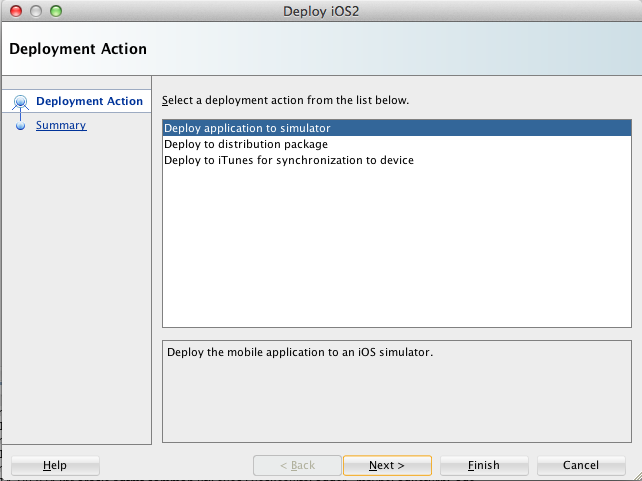
Tip:
As an alternative to the Deployment Action dialog, you can deploy a mobile application to the iOS platform manually using the OJDeploy command line tool as described in Deploying MAF Applications from the Command Line.
25.4.1 How to Create an iOS Deployment Profile
Use the Deployment Profiles Properties editor to create a deployment profile for the iOS platform. Ensure that prerequisites are met, and follow the steps in the task to create the profile by selecting iOS Options for deployment available under Application Properties in the Application menu.
For iOS, use the Deployment Profiles Properties editor to define the iOS application build configuration as well as the locations for the application icons.
Before you begin:
Download Xcode (which includes the Xcode IDE, performance analysis tools, the iOS simulator, and the Mac OS X and iOS SDKs) to the Apple computer that also runs JDeveloper.
Tip:
Refer to the Certification and Support Matrix on Oracle Technology Network (http://www.oracle.com/technetwork/developer-tools/maf/documentation) for the minimum supported version required to compile applications.
Because Xcode is used during deployment, you must install it on the Apple computer before you deploy the mobile application from JDeveloper.
Tip:
While the current version of Xcode is available through the App Store, you can download prior versions through the following site:
https://developer.apple.com/xcode/
Access to this site requires an Apple ID and registration as an Apple developer.
After you download Xcode, you must enter the location of its xcodebuild tool and, for deployment to iOS simulators, the location of the iOS simulator's SDK, in the iOS Platform preference page. See the Configuring the Development Environment for Platforms and Form Factors in Installing Oracle Mobile Application Framework.
Note:
Run both iTunes and the iOS simulator at least once before entering their locations in the iOS Platform preference page.
To deploy a mobile application to an iOS-powered device (as opposed to deployment to an iOS simulator), you must obtain both a provisioning profile and a certification from the iOS Provisioning Profile as described in Setting the Device Signing Options.
To create a deployment profile:
25.4.1.1 Defining the iOS Build Options
Build options allow you to deploy an application in the debug or release mode. If a provisioning profile and a signed certificate are available, follow the steps in the task to use the iOS Options page to set build options for the iOS platform.
The iOS build options enable you to deploy an application with debug or release bits and libraries.
Before you begin:
Deployment of an iOS application (that is, an .ipa file) to an iOS-powered device requires a provisioning profile, which is a required component for installation, and also a signed certificate that identifies the developer and an application on a device. You must obtain these from the iOS Provisioning portal as described in What You May Need to Know About Deploying an Application to an iOS-Powered Device. In addition, you must enter the location for a provisioning profile and the name of the certificate in the iOS Platform preference page, as described in Setting the Device Signing Options.
To set the build options:
When you deploy the MAF application in debug mode, a red icon appears on each screen of the MAF application, as shown in the upper-left portion of Figure 25-13. MAF applications that you deploy in release mode do not render this icon.
Figure 25-13 MAF Application Deployed in Debug Mode

25.4.1.2 Setting the Device Signing Options
Specify the location of the provisioning profile, the identifier of the development team, and the signing identity required for the deployment of an application to a distribution package or to iTunes for synchronization to a device.
The iOS Platform preferences page for iOS includes fields for the location of the provisioning profile on the development computer, the identifier of the team, and the name of the signing identity. You must define these parameters if you deploy an application to a distribution package or to iTunes for synchronization to a device. You use a signing identity to code sign your application. When Xcode requests your development certificate, the certificate and its public key is stored in the Member Center, and the signing identity (the certificate with its public and private key) is stored in your keychain. You will not be able to code sign without this private key.
Note:
Neither a signing identity nor a provisioning profile are required if you deploy a mobile application to an iOS simulator.
To set the signing options:
Note:
There are provisioning profiles used for both development and release versions of an application. While a provisioning profile used for the release version of an application can be installed on any device, a provisioning profile for a development version can only be installed on the devices whose IDs are embedded into the profile. See App Distribution Guide, which is available from the iOS Developer Library (http://developer.apple.com/library/ios/navigation/).
25.4.1.3 Adding a Custom Image to an iOS Application
Follow the steps in the task to rebrand an application by overriding the default Oracle images used for application icons and artwork with custom images.
The Application Images page enables you to rebrand an application by overriding the default Oracle image used for application icons and artwork with custom images. The options in this page, shown in Figure 25-15, enable you to enter the locations of custom images used for different situations, device orientation, and device resolutions. For more information on iOS application icon images, see Icon and Image Design section in iOS Human Interface Guidelines. This document is available from the iOS Developer Library (http://developer.apple.com/library/ios/navigation/).
Note:
All images must be in the PNG format.
To add custom images:
25.4.1.4 What You May Need to Know About iTunes Artwork
Applications that are deployed to an iOS device by means of iTunes use the default Oracle image. To differentiate between versions of an application you can select an iTunes artwork image as the icon for a deployed application.
By default, mobile applications deployed to an iOS device through iTunes use the default Oracle image unless otherwise specified.
By selecting an iTunes artwork image as the icon for the deployed application, you override the default image. You can use an image to differentiate between versions of the application. Figure 25-16 illustrates the difference between the default image and a user-selected image, where Application4 is displayed with the default image and Application6 is displayed with a user-selected image (the Oracle icon, scaled to 512 x 512 pixels).
Figure 25-16 Custom and Default Application Icons

During deployment, MAF ensures that the icon displays in iTunes by adding the iTunes artwork image to the top-level of the .ipa file in a file called iTunesArtwork.
Note:
iTunes artwork is only packaged into the application when you select the deployment type called Deploy to iTunes for synchronization to device.
25.4.1.5 How to Restrict the Display to a Specific Device Orientation
MAF supports all device display orientations for iPhone and iPad. Follow the steps in the task to restrict the display of an application to a specific device orientation.
By default, MAF supports all orientations for both iPhone and iPad. If, for example, an application must display only in portrait and in upside-down orientations on iPads, you can limit the application to rotate only to these orientations using the Device Orientation page, shown in Figure 25-17
Figure 25-17 Select a Device Orientation
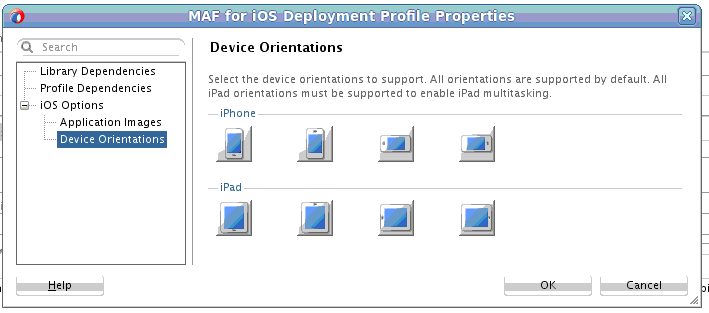
To limit the display of an application to a specific device orientation:
25.4.1.6 What Happens When You Deselect Device Orientations
When you deselect a device orientation, the source .plist file gets updated.
Deselecting a device orientation updates the source .plist file.
All iPad orientations must be supported (selected) to enable iPad multitasking. When iPad multitasking is enabled, features such as split view mode can be used on compatible iOS devices.
25.4.2 How to Deploy an iOS Application to an iOS Simulator
Ensure that prerequisites are met, and follow the steps in the task to deploy an application to an iOS simulator using the Deploy application to simulator option for Deploy.
The Deployment Actions dialog enables you to deploy an iOS application directly to an iOS simulator.
Before you begin:
To enable deployment to an iOS simulator, you must perform the following tasks:
-
Run Xcode after installing it, agree to the licensing agreements, and perform other post-installation tasks, as prompted.
Note:
You must run Xcode at least once before you deploy the application to the iOS simulator. Otherwise, the deployment will not succeed.
-
On the iOS Options page of the deployment profile, select Debug, and then click OK.
-
Before you deploy an application, shut down the iOS simulator if it is running. If you do not shut down the simulator, the deployment will do it for you.
-
See Simulator User Guide, available in the iOS Developer Library (
http://developer.apple.com/library/ios/navigation/). The iOS simulator is installed with Xcode.
To deploy an application to an iOS simulator:
25.4.3 How to Deploy an Application to an iOS-Powered Device
Members of iOS Developer Program or the iOS Developer Enterprise Program can follow the steps in the task to deploy an application to an iOS-powered device by using the Deploy to iTunes for Synchronization to device for Deploy. You can also change the default directory for the iTunes Media folder.
The Deploy to iTunes for Synchronization to device option enables you to deploy a mobile application to an iOS-powered device for debugging and testing. Deployment to an iOS-powered device or to a distribution site requires membership to either the iOS Developer Program or the iOS Developer Enterprise Program. For more information, see https://developer.apple.com/programs/.
Before you begin:
You cannot deploy an application directly from JDeveloper to an iOS device; an application must instead be deployed from the Applications folder in Apple iTunes. To accomplish this, you must perform the following tasks:
-
Download Apple iTunes to your development computer and run it at least once to create the needed folders and directories.
-
Set the location of the
Automatically Add to iTunesfolder (the location used for application deployment) in the iOS Platform preference page, shown in Figure 25-18.Tip:
Although your user home directory (
/Users/<username>/Music/iTunes/iTunes Media/Automatically Add to iTunes.localized) is the default directory for the iTunes Media folder, you can change the location of this folder as follows:-
In iTunes, select Edit, Preferences, then Advanced.
-
Click Change and then browse to the new location.
-
Consolidate the library.
-
Delete the original iTunes Media folder.
For instructions, refer to Apple Support (
http://support.apple.com).You must also update the location in the iOS Platform preferences page.
Figure 25-18 Setting the Location for the iTunes Media Folder
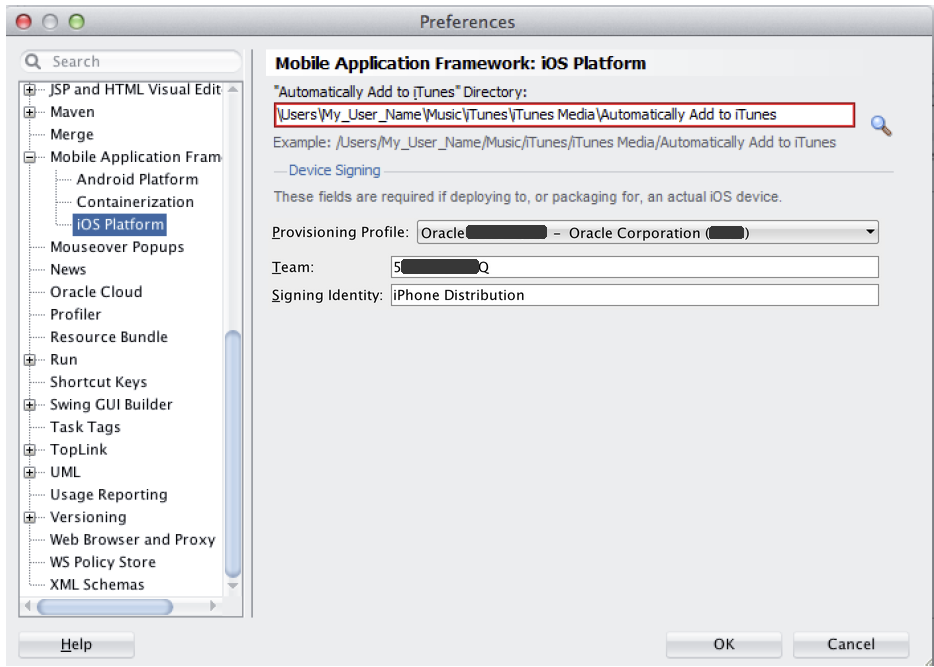
-
-
Enter the name and location of the provisioning profile, the team identifier, and the signing identity in the iOS Platform preference page. The OS Provisioning Portal generates the certificate and provisioning profile needed for deployment to iOS devices, or for publishing
.ipafiles to the App Store or to an internal download site.Note:
The deployment will fail unless you set the iOS provisioning profile, team identifier, and signing identity to deploy to a device or to an archive. MAF logs applications that fail to deploy under such circumstances. For more information, see What You May Need to Know About Deploying an Application to an iOS-Powered Device.
-
On the iOS Options page of the deployment profile, select Debug as the build mode and then OK.
-
Refer to App Distribution Guide, which is available through the iOS Developer Library (
http://developer.apple.com/library/ios/navigation/).
To deploy an application to an iOS-powered device:
-
Select Applications, then Deploy, and then select an iOS deployment profile.
-
Select Deploy to iTunes for Synchronization to device and then choose Next.
-
Review the Summary page, which displays the following values. Click Finish.
-
Application Bundle Id—The unique name that includes a Java language-like package name (com.<organization name>.<application name>) prefixed with the Bundle Seed that is generated from the iOS Provisioning Portal.
-
File—The file name of the final image deployed to an iOS target.
-
Signature—The developer (or company) who authored the application. If this value has not been configured in the iOS Platform preferences page, then the Summary page displays <Not Specified>.
-
Provisioning Profile—The name of the provisioning profile that associates one or more development certificates and devices with an application ID. If this value is not configured in the iOS Platform preferences page, then the Summary page displays <Not Specified>.
-
Team—The identifier of the team. MAF automatically populates this input field with a value that it extracts from the provisioning profile.
Note:
You must specify the Signature, Team, and Provisioning Profile values in the iOS Platform preferences page to enable deployment to iTunes.
-
-
Connect the iOS-powered device to the development computer.
-
Open iTunes and then synchronize the device.
25.4.4 What Happens When You Deploy an Application to an iOS Device
The application appears in the iTunes Apps Folder, similar to the one illustrated in Figure 25-16 after a successful deployment.
25.4.5 What You May Need to Know About Deploying an Application to an iOS-Powered Device
A provisioning profile must be created using the iOS Provisioning Portal before an application can be deployed to an iOS-powered device.
You cannot deploy an iOS application (that is, an .ipa file) to an iOS-powered device or publish it to either the App Store or to an internal hosted download site without first creating a provisioning profile using the iOS Provisioning Portal, which is accessible only to members of the iOS Developer Program. You enter the location of the provisioning profile and the name of the certificate in the iOS Platform preferences page as described in Setting the Device Signing Options.
As noted in App Distribution Guide (which is available in the iOS Developer Library at http://developer.apple.com/library/ios/navigation/), a provisioning profile associates development certificates, devices, and an application ID. The iOS Provisioning Portal enables you to create these entities as well as the provisioning profile.
Tip:
After you download the provisioning profile, double-click this file to add it to your Library/MobileDevice/Provisioning Profile directory.
Figure 25-19 The iOS Provisioning Portal
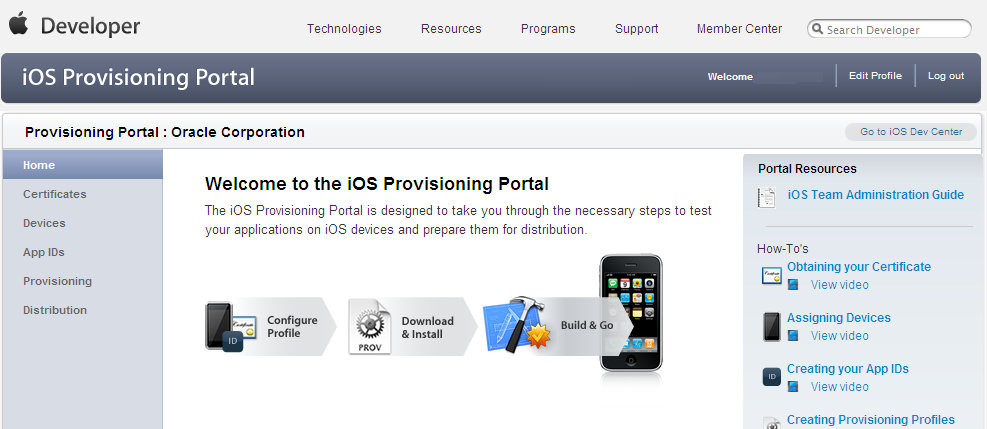
25.4.5.1 Creating iOS Development Certificates
An iOS Development Certificate electronically associates a developer identity with a public key and private key. Download and install a certificate on the development computer to sign applications for deployment.
A certificate is an electronic document that combines information about a developer's identity with a public key and private key. After you download a certificate, you essentially install your identity into the development computer, as the iOS Development Certificate identifies you as an iOS developer and enables the signing of the application for deployment. In the iOS operating environment, all certificates are managed by the Keychain.
Using the Certificates page in the iOS Provisioning Portal, you log a CSR (Certificate Signing Request). The iOS Provisioning Portal issues the iOS Development Certificate after you complete the CSR.
25.4.5.2 Registering an Apple Device for Testing and Debugging
An Apple device must be included the Current Available Devices list on the Devices page on iOS Provisioning Portal so that it is uniquely identified as a device to which applications can be deployed.
After you install a certificate on your development computer, review the Current Available Devices tab (located in the iOS Provisioning Portal's Devices page) to identify the Apple devices used by you (or your company) for testing or debugging. The application cannot deploy unless the device is included in this list, which identifies each device by its serial number-like Unique Device Identifier (UDID).
25.4.5.3 Registering an Application ID
Application IDs uniquely identify applications on a device. An application ID consists of a Bundle ID, identical to the application ID on the Preferences page for the iOS Platform, and a 10-character alpha-numeric prefix from Apple.
An application ID is a unique identifier for an application on a device. An application ID is comprised of the administrator-created reverse domain name called a Bundle Identifier in the format described in Setting Display Properties for a MAF Application prefixed by a ten-character alpha-numeric string called a bundle seed, which is generated by Apple. Figure 25-20 illustrates an application ID that is unique, one that does not share files or the Keychain with any other applications.
Figure 25-20 An Explicit Application ID
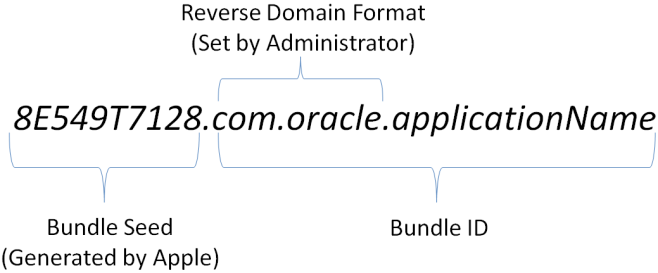
Using a wildcard character (*) for the application name, such as 8E549T7128.com.oracle.*, enables a suite of applications to share an application ID. For example, if the administrator names com.oracle.MAF.* on the iOS Provisioning Portal, it enables you to specify different applications (com.oracle.MAF.application1 and com.oracle.MAF.application2).
Note:
For applications that receive push notifications, the application ID must be a full, unique ID, not a wildcard character; applications identified using wildcards cannot receive push notifications. See Provisioning and Development of Local and Push Notification Programming Guide, available in the iOS Developer Library (http://developer.apple.com/library/ios/navigation/)
When applications share the same prefix, such as 8E549T7128, they can share files or Keychains.
Note:
The Bundle ID must match the application ID set in the iOS Platform preferences page.
25.4.6 How to Distribute an iOS Application to the App Store
After debugging and testing an application on an iOS device, it can be published to the App Store or an internal download site for wider distribution. Ensure that prerequisites are met, and follow the steps in the task to publish an iOS application to the App Store.
After you test and debug an application on an iOS device, you can distribute the application to a wider audience through the App Store or an internal download site. To publish an application to the App Store, you must submit the .ipa file to iTunes Connect, which enables you to add .ipa files to iTunes, as well as update applications and create test users.
Before you begin:
Before you distribute the application, you must perform the following tasks:
-
In the iOS Platform preference page, shown in Figure 25-18, enter the location of the
Automatically Add to iTunesdirectory.Tip:
Run iTunes at least once before entering this location. See also How to Deploy an Application to an iOS-Powered Device.
-
Test the application on an actual iOS device. See How to Deploy an Application to an iOS-Powered Device.
-
Obtain a distribution certificate through the iOS Provisioning Portal.
Note:
Only the Team Agent can create a distribution certificate.
-
Obtain an iTunes Connect account for distributing the
.ipafile to iTunes. For information, refer to the App Store distribution guidelines at http://developer.apple.com/. -
You may want to review the iTunes Connect Developer Guide available through the iOS Developer Library (
http://developer.apple.com/library/ios/navigation/). -
In the iOS Options page of the deployment profile, select App Distribution Guide Release as the build mode and then click OK.
To distribute an iOS application to the App Store:
25.5 Deploying a MAF Application to the Universal Windows Platform
MAF applications can either be deployed in the release or debug mode to the local development computer or to an installation package using a PowerShell script. Complete the listed setup and configuration tasks, and deploy the application with the ready-to-use Windows1 deployment profile.
MAF applications can either be deployed to the local machine on which you develop the application, or to an installation package that you use to install the application on a supported UWP device.
MAF provides two build modes for an application that is to be deployed to the UWP. Use the debug mode to test and debug your application as you go through the development cycle. Use the release mode to deploy an application that is release ready.
Release ready applications cannot be published to the Windows Store. Choose another mechanism to distribute your application. MAF provides a PowerShell script in the installation package that, when executed, installs the application on the UWP device.
Perform the following setup and configuration tasks before you attempt to deploy an application to the UWP:
-
Verify that your development machine meets the requirements to deploy a MAF application to the UWP. The UWP device that you use must run the Windows 10 operating system. You must enable Developer mode on this machine.
For more information, see the Installation Requirements for MAF Applications to be Deployed to the Windows Platform section in Installing Oracle Mobile Application Framework.
-
Install the Visual Studio software from Microsoft. The Visual Studio package contains the Windows SDK required to deploy applications to the UWP.
For more information, see the Setting Up Development Tools for the Universal Windows Platform section in Installing Oracle Mobile Application Framework.
-
Create a certificate (a personal information exchange file) to digitally sign the application you want to deploy.
For more information, see the Creating a PFX File for MAF Applications section in Installing Oracle Mobile Application Framework.
-
Enter the following values in the Windows Platform dialog shown in Figure 25-21:
-
The location of the Windows SDK that is installed with the Visual Studio software.
-
The location and password (if required) for the certificate that you use to sign the application. Do this in both the Debug and Release dialogs if you intend to deploy your MAF application in both the modes.
-
Ignore the Hash Algorithm field. MAF does not use it.
You access the Windows Platform dialog from the JDeveloper Tools menu by clicking Preferences, and then clicking Mobile Application Framework as shown in Figure 25-21.
-
Figure 25-21 Windows Platform Preferences to Deploy a MAF Application
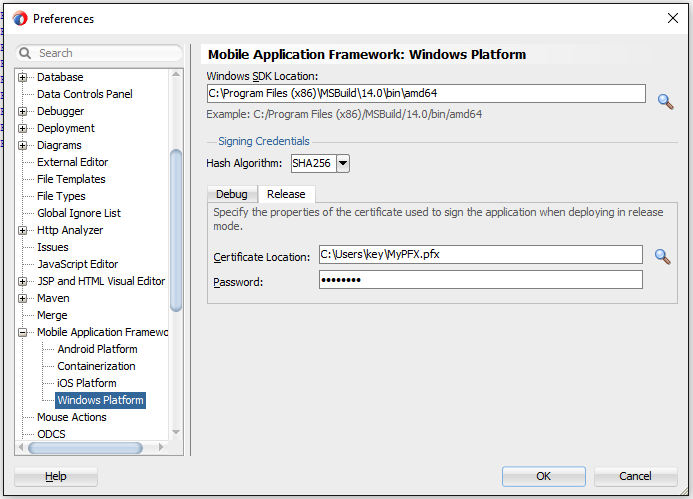
MAF provides a ready-to-use deployment profile (Windows1) to deploy a MAF application in the debug mode. Provided your development machine and environment meet the setup and configuration requirements, you can deploy the application either to a local machine or to a package.
You can edit this ready-to-use deployment profile or create one or more new deployment profiles. By creating a new deployment profile, or by editing an existing profile, you can:
-
Specify additional library and profile dependencies for your application.
-
Choose either the debug or release build modes.
-
Specify options such as the application bundle ID, the archive name and version.
-
Specify the images that the application uses to render its logo on the splash screen and the icon that appears on the user’s device.
For more information about how to edit or create a deployment profile, see Working with Deployment Profiles. Click Help in the deployment profile dialogs for information about the fields that you can configure in each dialog.
Before you deploy your application, note the following issues that can hinder deployment:
-
Microsoft Windows imposes a maximum length for the path to directories and files. MAF application deployment fails if the path for a MAF application exceeds the maximum path length. To work around this issue, place the MAF application in a location where the directory path length is less than the maximum length mandated by Windows. For more information about the maximum path length limitation, see Microsoft’s documentation.
-
Ensure no other process uses the MAF application’s data folder before you deploy the MAF application using the
Deploy application to local machineoption. The application data folder is typically located atC:\Users\[userName]\AppData\Local\Packages\[appBundleId]_[id]. An example of a scenario where another process uses this folder is if you have a file in the folder open with an application, such as Notepad. If you cannot determine what application process is using the directory/file(s), reboot your machine to resolve the issue. -
When an application, which uses the Contacts plugin, is deployed to the UWP, ensure that the Contacts plugin is listed first in the list of plugins in the
maf-plugins.xmlfile.
For information about how to debug an application that you deploy in the debug mode, see How to Debug Java Code on the Universal Windows Platform.
25.5.1 How to Deploy a MAF Application to the Universal Windows Platform
Deploy the application using a MAF for Windows deployment profile that deploys the application to the UWP.
25.5.2 What Happens When You Deploy a MAF Application to the Universal Windows Platform
Depending on whether you select the Deploy application to local machine option, or the Deploy application to package option, MAF deploys the application to a computer or to an installation package.
If you select the Deploy application to local machine option, MAF deploys the application to the machine that you are using and installs the application there. In the foreground of Figure 25-22 is an instance of the WorkBetter sample application that has been deployed to a local machine in release mode. In the background of Figure 25-22, you can view the WorkBetter sample application listed among the installed applications on the Apps & features page of the Windows 10 computer.
A red icon appears in the upper-left of a MAF application screen that you deploy in debug mode to indicate that the application is in debug mode. As with the application deployed in release mode, you can view and uninstall this application in the Apps & features page of the Windows 10 computer.
Figure 25-22 MAF Application Deployed in Release Mode on Windows Local Machine
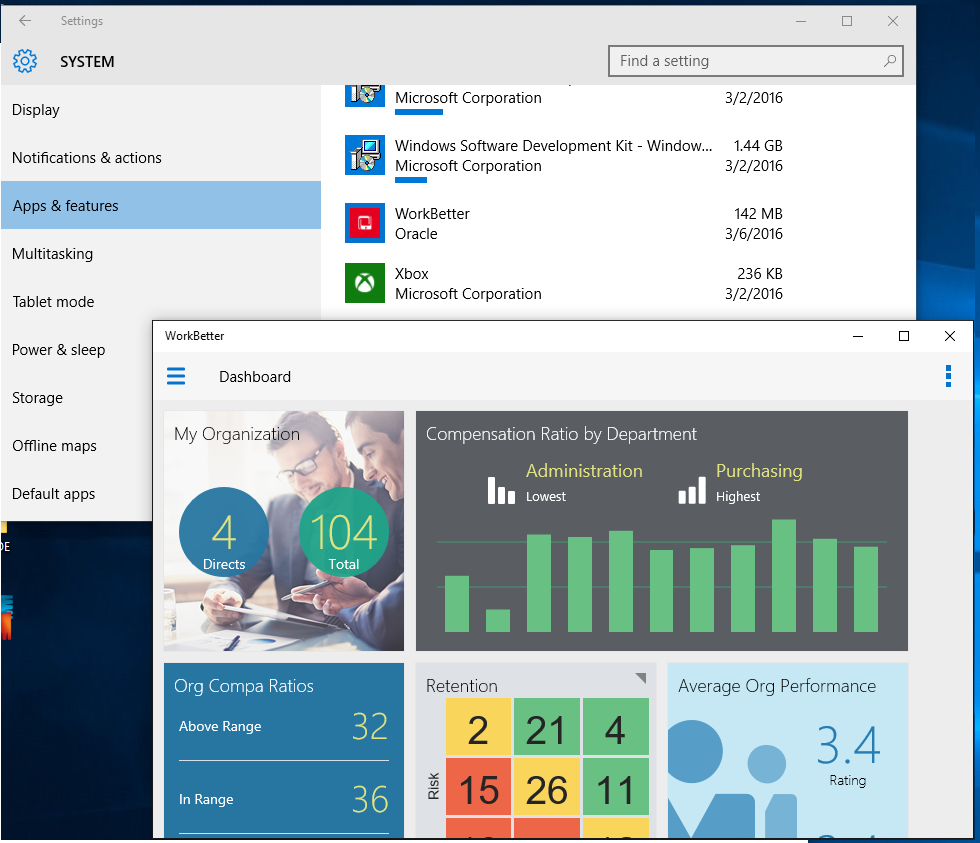
If you select the Deploy application to package option, MAF deploys the application to an installation package in the following directory:
C:\path\to\appRoot\deploy\[DeploymentProfileName]\[deployMode]\MafTemplate\AppPackages
For example, the WorkBetter sample application, shown in Figure 25-22, that deployed in release mode using the Windows1 deployment profile deployed to the following directory:
C:\...\PublicSamples\WorkBetter\deploy\Windows1\release\MafTemplate\AppPackages
The AppPackages directory contains another directory (MafTemplate_*_Test). Distribute the contents of this latter directory to the end users with supported UWP devices who want to install your MAF application. The directory includes a PowerShell script (Add-AppDevPackage.ps1) that end users execute to install the application. In addition to the script, the directory contains the application package, dependent packages, and the certificate that signed the application. The following example lists the contents:
Add-AppDevPackage.ps1 Add-AppDevPackage.resources Dependencies MafTemplate_1.0.0.0_x64.appx MafTemplate_1.0.0.0_x64.appxsym MafTemplate_1.0.0.0_x64.cer
The name of the MafTemplate_*_Test directory and files depends on the Version number and Build mode that you specify in the Windows Options dialog, shown in Figure 25-23. You access this dialog from JDeveloper’s Deployment page when you edit a deployment profile. To access the Deployment page, click Application and then Application Properties.
For example, if you specify 2 as the Version number and select the Debug build mode, the directory name is MafTemplate_2.0.0.0_x64_Debug_Test. A version number of 3 and the Release build mode produces a MafTemplate_3.0.0.0_x64_Test directory.
Figure 25-23 Windows Options Dialog for Deployment Profile
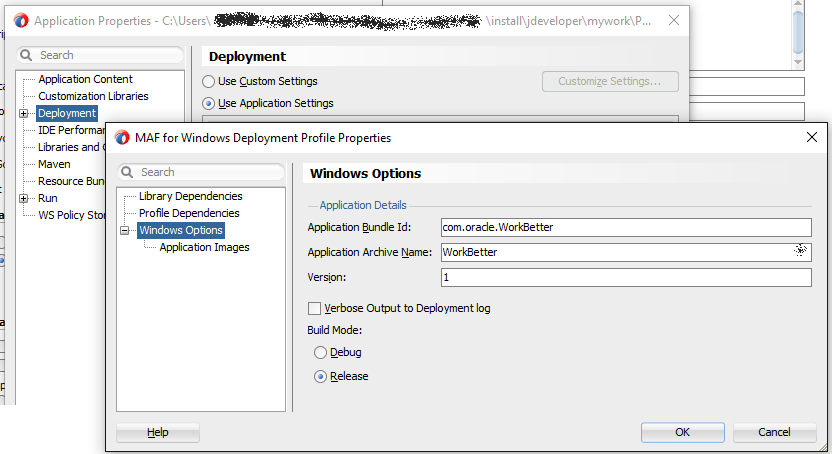
25.6 Overview of MAF Quick Deployment of Applications
A quick deployment skips some deployment steps to save deployment time. Quick deployment saves time by passing only new or changed file content to an emulator or a simulator.
MAF quick deployment ensures developer productivity by providing competitive deployment times without deterioration of performance.
Quick Deployment of Applications
A quick deployment, as opposed to the normal full deployment, saves deployment time by skipping some deployment steps. A quick deployment passes only new or changed file content to an emulator or a simulator.
To use quick deployment on an Android emulator, select the Deploy application to emulator deployment action. For example, for a deployment profile named Android2, on the Application menu, select Deploy, then Android2, and then select a deployment action. See Deploy an Android Application to an Android Emulator. To use quick deployment on an iOS simulator, for a deployment profile named iOS2, from the Application menu, select Deploy, then iOS2, and then select a deployment action. See Deploy an iOS Application to an iOS Simulator.
Note:
The first deployment is a full deployment. A quick deployment may follow an initial full deployment.The deployment of an application to an emulator or a simulator starts a Quick Deployment Session Analysis. The results of the analysis decide whether the deployment must be a quick deployment or a full deployment.
The Quick Deployment Session Analysis is initiated to detect application file changes. The MAF tool that analyzes application file changes triggers a quick deployment. If the analysis fails to find deployment artifacts from a previous Quick Deployment Session that used the same deployment profile, a full deployment is triggered.
MAF simplifies the deployment functionality. When you make changes to application files in JDeveloper, those changes are moved to the application that is deployed to an emulator or a simulator, thus removing the need for redeployment.
Key Features of Quick Deployment
The following features define quick deployment.
-
Quick deployment is supported for applications that are deployed to an Android emulator or an iOS simulator.
-
Virtual box images can be used for quick deployment provided that root access is configured for the images.
-
Changes made to an application in JDeveloper pushes the changes to the application deployed to an emulator or a simulator, without a full deployment, for example, changes to AMX pages or task flows. For the complete list of application changes, see Artifacts That Support Quick Deployment.
-
Deletion of files triggers a full deployment.
-
The quick deployment of an application only updates new or modified files. Quick deployment does no additional deployment processing.
25.6.1 About the Artifacts That Support Quick Deployment
Changes to certain artifacts, AMX pages, binding changes, and others, support MAF quick deployment.
Artifact Changes That Support MAF Quick Deployment
The following artifact changes support quick deployment:
-
Changes to AMX pages
-
Changes to task flows
-
Changes to bindings
-
Changes to maf-skins.xml
-
Addition of new style sheets and referencing them in maf-skins.xml
-
Changes to maf-config.xml
-
Changes to adf-config.xml
-
Changes to connections.xml
-
Changes to wsm-assembly.xml
-
Changes to sync-config.xml
25.6.2 About Requirements for Quick Deployment
A quick deployment is only initiated if the listed prerequisites are met.
Prerequisites for the Quick Deployment of a MAF Application
The quick deployment of an application starts when the following requirements are met:
-
An installed application is available on the target Android emulator or iOS simulator.
-
A unique bundle id for the MAF application.
-
An initial, full deployment must have been completed.
25.6.3 What Happens During a Quick Deployment Session
A Quick Deployment Session analyzes and determines whether a deployment must be a quick deployment or a full deployment. The session is initiated when an application is deployed.
The deployment of an application to an emulator or a simulator starts a Quick Deployment Session. The session analyzes and decides whether the deployment must be a quick deployment or a full deployment.
MAF Quick Deployment Session and Analysis
A quick deployment session proceeds as follows:
-
Conducts an initial quick deployment session analysis
-
Notes the application file changes:
-
Since the last quick deployment session
-
With the same deployment profile
-
-
If the changed files support quick deployment, the following steps for a quick deployment are completed. Otherwise, a full deployment follows.
-
Copies the modified files to the emulator or simulator
-
Restarts the application on the emulator or simulator
-
25.6.4 How to Start the Full Deployment of an Application
Certain actions can trigger the full deployment of an application. If you want the full deployment of an application, initiate an action from the list.
Actions That Trigger the Full Deployment of an Application
The following actions trigger the full deployment of an application:
-
JDeveloper is restarted.
-
Files are changed in non-MAF projects.
-
Java files in a MAF feature project are created, changed, or deleted.
-
Files are changed in a non-MAF project, and a Clean All is performed before deployment.
-
Files are deleted in the application, outside of MAF feature projects.
-
An application is deployed using a different deployment profile, a profile other than the one used in the previous quick deployment.
-
Some artifacts at the application level can trigger a full deployment. Changes to the following artifacts trigger a full deployment:
-
maf-application.xml
-
maf-feature.xml
-
maf-plugins.xml
-
maf.properties
-
logging.properties
-
25.6.5 How to Force the Full Deployment of an Application
Certain actions, when initiated, can force the full deployment of an application. Initiate an action from the list to start a full deployment.
Certain user actions force the full deployment of a MAF application.
Actions That Force the Full Deployment of a MAF Application
The full deployment of an application can be forced in multiple ways. Use any of the following actions to trigger the full deployment of a MAF application:
-
Change any file that does not support quick deployment.
-
Click Build, and then click Clean All.
-
Uninstall an application on the Android emulator or iOS simulator.
-
Restart JDeveloper.
25.6.6 What You May Need to Know About Quick Deployment Limitations
Some limitations are associated with the quick deployment of MAF applications. The lists enumerate the limitations.
Quick Deployment Limitations: Files Deployment and User Actions
The following files cannot be deployed by means of quick deployment because they need additional processing during deployment:
-
Files that are created, updated, or deleted in any project other than a MAF ViewController or ApplicationController project
-
Application files that are deleted outside MAF feature projects
-
Files that are deleted from within any MAF feature project
-
New, changed, or deleted Java files
-
Changes to the following artifacts at the application level trigger a full deployment:
-
maf-application.xml -
maf-feature.xml -
maf-plugins.xml -
maf.properties -
logging.properties
-
A quick deployment cannot be initiated in the context of the following user actions:
-
Changes or removes the emulator application that was installed by the previous quick deployment.
-
Deploys an application using a deployment profile other than the one used in the previous quick deployment.
Quick deployment neither detects nor handles the following changes:
-
The quick deployment of an application to a different emulator.
-
JDeveloper restart. After JDeveloper restarts, the first deployment is a full deployment. No user action is needed to ensure a full deployment after the restart. A quick deployment may follow an initial full deployment.
25.7 Deploying Feature Archive Files (FARs)
To enable re-use by MAF view controller projects, application features— typically, those implemented as MAF AMX or Local HTML— are bundled into an archive known as a Feature Archive (FAR).
As stated in Reusing MAF Application Content , a FAR is a JAR file that contains the application feature artifacts that can be consumed by mobile applications, such as icon images, resource bundles, HTML, JavaScript, or other implementation-specific files. (A FAR may contain Java classes, though these classes must be compiled.) The following example illustrates the contents of a FAR, which includes a single maf-feature.xml file and a connections.xml file. For more information on connections.xml, see Configuring End Points Used in MAF Applications .
/* Contents of a Feature Archive File */
connections.xml (or some form of connection metadata)
META-INF
adfm.xml
maf-feature.xml
MANIFEST.MF
task-flow-registry.xml
oracle
application1
mobile
Class1.class
DataBindings.cpx
pageDefs
view1PageDefs
model
adfc-mobile-config.adfc.diagram
ViewController-task-flow.adfc.diagram
public_html
adfc-mobile-config.xml
index.html
navbar-icon.html
springboard-icon.html
view1.amx
ViewController-task-flow.xml
Working with Feature Archive files involves the following tasks:
-
Creating a Feature Archive file—You create a Feature Archive by deploying a feature application as a library JAR file.
-
Using the Feature Archive file when creating a mobile application—This includes importing FARs and re-mapping the imported connection.
-
Deploying a mobile application that includes features from FARs—This includes unpacking the FAR to a uniquely named folder within the deployment template.
Note:
MAF generates FARs during the deployment process. You only need to deploy a view controller project if you use the FAR in another application.
25.7.1 How to Create a Deployment Profile for a Feature Archive
Create connections for the application, and then follow the steps in the task to create a deployment profile for a feature archive.
Use the Create Deployment Profile dialog, shown in Figure 25-24.
Figure 25-24 Create MAF Feature Archive Dialog

Before you begin:
Create the appropriate connections for the application. Because FARs may be used in different MAF applications with different connection requirements, choose a connection name that represents the connection source or the actual standardized connection name.
To create a deployment profile for a Feature Archive:
25.7.2 How to Deploy the Feature Archive Deployment Profile
MAF provides the Deploy to feature archive JAR file option so that you can deploy a FAR as a JAR file. Follow the steps in the task to deploy the Feature Archive deployment profile.
The Deployment Actions dialog enables you to deploy the FAR as a JAR file. This dialog, shown in Figure 25-26, includes only one deployment option, Deploy to feature archive JAR file.
Figure 25-26 Deployment Actions

To deploy the Feature Archive deployment profile:
25.7.3 What Happens When You Deploy a Feature Archive File Deployment Profile
MAF packages the content of the application feature into a JAR file (FAR) that it creates in the AppRoot/ViewController/deploy directory. This FAR includes AMX pages, task flows, icons, and the other resources that comprise the application feature.
The FAR does not include any shared libraries that the application feature consumed. Review the output in JDeveloper’s Deployment – Log window (Window > Log). If the application feature that you deployed to the FAR includes a shared library, MAF logs a message to notify you that the shared library has been excluded from the FAR. Notify MAF application developers who want to consume the FAR in their applications that they need to obtain the shared library separately if they want to use the shared library resources in their applications when they consume the FAR. For more information about shared libraries, see Reusing MAF Application Content with a MAF Shared Library.
MAF application developers who consume a FAR in their MAF application need to create a file system connection to the directory that contains the FAR. Once they create this connection, the FAR and the application feature(s) it packages appear in the Resources window, as shown by Figure 25-28. For more information about consuming a FAR in a MAF application, see Using FAR Content in a MAF Application.
Figure 25-28 Deployed Feature Archive JARs in the Resources Window

25.8 Creating a Mobile Application Archive File
A new mobile application can be created from an existing mobile application by packaging the original mobile application as a Mobile Application Archive (.maa) file or by creating a new mobile application from the .maa file.
You can create a new mobile application from an existing mobile application by:
-
Packaging the original mobile app as a Mobile Application Archive (
.maa) file -
Create a new mobile application from the .maa file, as described in Creating a New Application from an Application Archive.
An .maa file preserves the structure of the mobile application. Table 25-4 describes the contents of this file.
Table 25-4 Contents of a Mobile Application Archive File
| Directory | Description |
|---|---|
|
|
Contains the
|
|
|
Contains a JAR file for each project in the workspace. For example, a |
|
|
Contains the application-level libraries (including FARs) that are external to the original mobile application. |
|
|
Includes the |
|
|
Includes the following directories:
|
In addition to the artifacts listed in Table 25-4, the .maa file includes any folder containing FARs or JAR files that are internal to the original mobile application, as well as its control (.jws)file. See also What Happens When You Import a MAF Application Archive File.
Note:
Importing an .maa file into an existing application overwrites the workspace and project container files (the.jws and .jpr files, respectively). As a result, all prior changes to MAF AMX pages and configuration files, such as maf-application.xml, maf-config.xml, connections.xml, and adf-config.xml, will not be retained.
25.8.1 How to Create a Mobile Application Archive File
Follow the steps in the task to use Mobile Application Archive wizard to create a .maa file. You can also create a .maa file using OJDeploy.
JDeveloper creates a default MAF Application Archive deployment profile after you create a mobile application. Using the Mobile Application Archive wizard, you can create the .maa file.
Tip:
You can also create an .maa file using OJDeploy, as described in Deploying MAF Applications from the Command Line.
To create a Mobile Application Archive file:
-
Click Application, then Deploy, then New Deployment Profile.
-
In the Create Deployment Profile dialog, select MAF Application Archive and then click OK, as shown in Figure 25-29.
Figure 25-29 Creating an MAA Deployment Profile
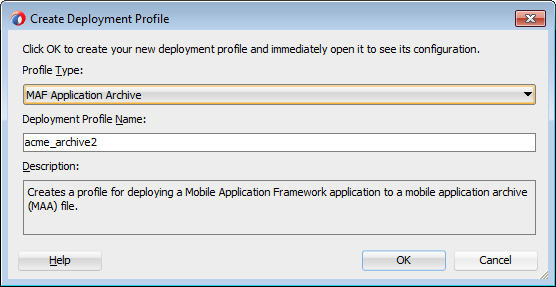
-
If needed, enter a name for the Mobile Application Archive in the Application Archives Options page, shown in Figure 25-30, or accept the default name (and path). Click OK.
Figure 25-30 Entering a Name and Path for the Mobile Application Archive File
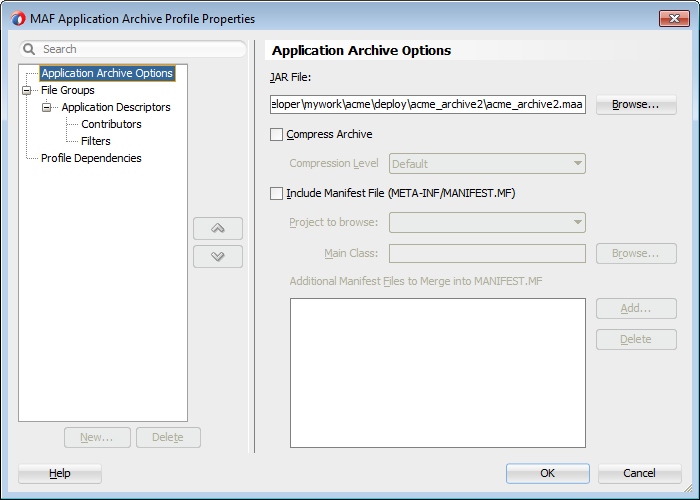
-
If needed, perform the following:
-
In the Application Descriptors page, shown in Figure 25-31, enter the file group name (or accept the default name) used for the contents of the
META-INFfolder (application_workspace\src\META-INF).Figure 25-31 Entering a File Group Name for the META-INF Contents
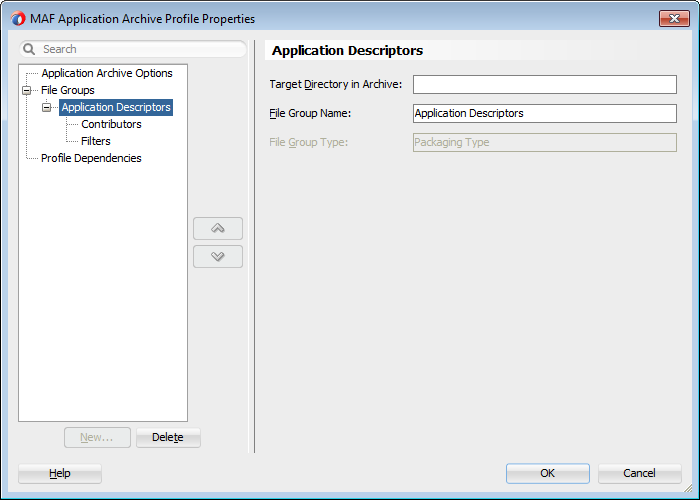
-
Select the Contributors sub-page of this Application Descriptors page to edit the list of directories and JAR files that provide the contents for the file group.
Figure 25-32 Editing Contributors to the Mobile Application Archive File
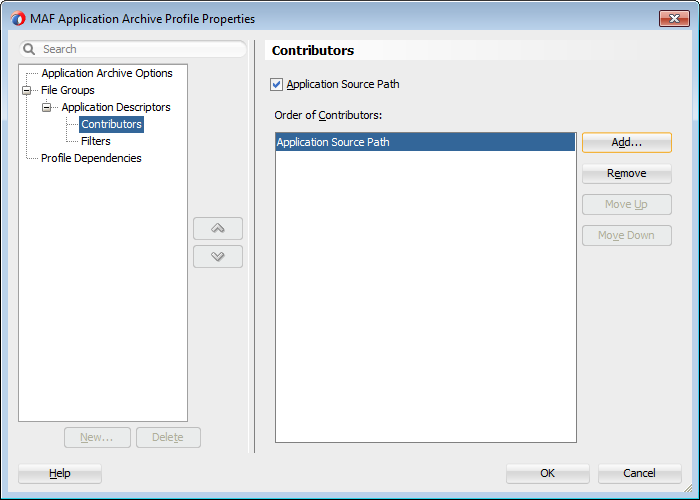
-
Use the Filters page, shown in Figure 25-33 to edit the files that will be included in the
.maafile or set the content inclusion or exclusion rules.Figure 25-33 Including (or Excluding) Files and Directories
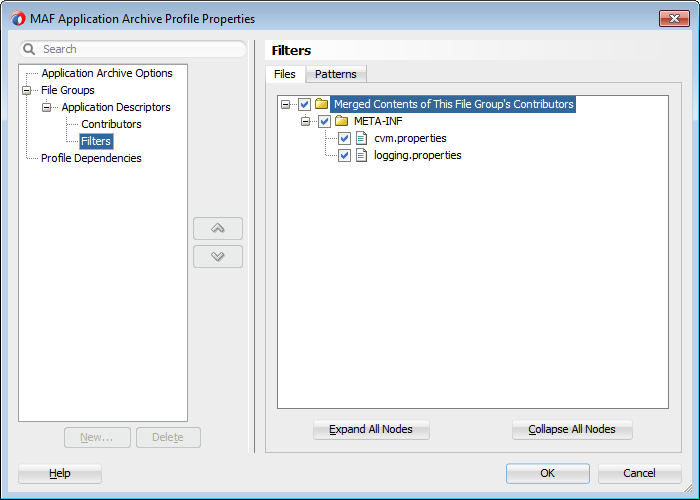
-
Use the Profile Dependencies page, shown in Figure 25-34, to specify dependent profiles within the project.
Figure 25-34 Selecting Deployment Profiles

-
To package a mobile application as a MAF Application Archive file:
-
Choose Application, then Deploy and then choose the MAF Application Archive deployment profile.
-
In the Deployment Action wizard, select Deploy application to MAA, as shown in Figure 25-35.
Figure 25-35 Deployment to a MAF Application Archive File

-
Click Next to review the deployment summary, as shown in Figure 25-36.
Figure 25-36 MAF Application Archive Deployment Summary
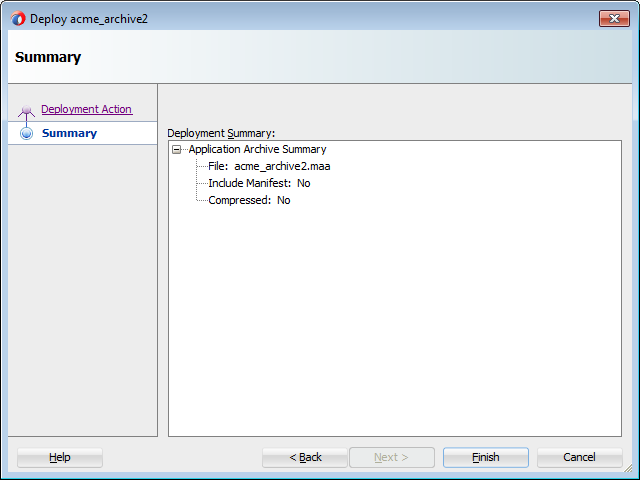
-
Click Finish.
25.9 Creating a New Application from an Application Archive
Use an application archive file to create a new MAF application that facilitates various customizations.
You or others (for example, a colleague or a partner) can create a new MAF application using an application archive file (.maa) as a starting point. By deriving a mobile application from an .maa file, you enable various customizations, which include:
-
Giving an application a unique application ID (to enable push notifications, for example).
-
Signing an application with a company-specific credential or certificate.
-
Replacing the resources with customized splash screens and application icons.
The MAF Application Archive (.maa) file format enables you to provide third-parties with an unsigned mobile application.
Note:
Importing an .maa file into an existing application overwrites the workspace and project container files (the.jws and .jpr files, respectively). As a result, all prior changes to MAF AMX pages and configuration files, such as maf-application.xml, maf-config.xml, connections.xml, and adf-config.xml, will not be retained.
25.9.1 How to Create a New Application from an Application Archive
Follow the steps in the task to use the MAF Application from Archive File option and import a.maa file into a new mobile application.
You import an .maa file into a new mobile application.
To create a new application from an application archive:
-
Select File and then New.
-
In the New Gallery, select Applications and then MAF Application from Archive File.
Note:
Alternatively, you can select File, then Import, and then MAF Application from Archive File.
-
In the Location page, select Browse in the MAA File field to navigate to the location of the MAA file.
-
If needed, perform the following, or accept the default values:
-
Enter a name for the mobile application derived from the
.maafile in the Application File field, as shown in Figure 25-37. -
Click Browse to retrieve the directory of the mobile application.
Figure 25-37 Entering the Directory Location
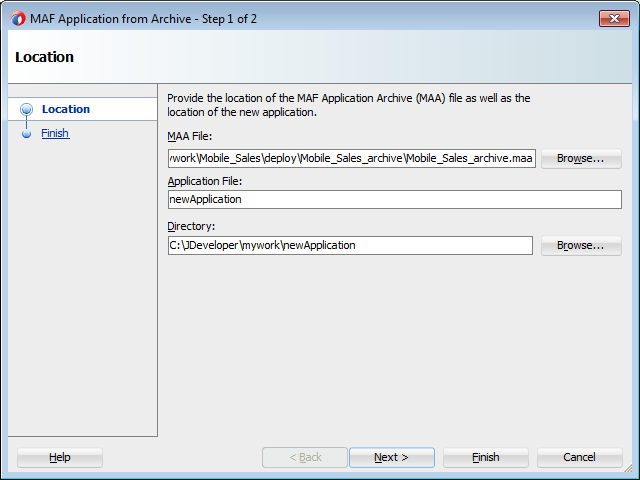
-
-
Click Next to review the import summary information and then click Finish.
25.9.2 What Happens When You Import a MAF Application Archive File
MAF creates an application folder into which it unpacks relevant directories and their contents. For every JAR file within the Projects directory, MAF creates a project folder, and unpacks the contents of the JAR files into the appropriate project folder.
MAF performs the following after you import an .maa file:
-
Creates an application folder.
-
Unpacks the workspace container (
.jws) file from the.maafile to the application file and renames it per the user-specified value. -
Unpacks the
adfdirectory and its contents to the application folder. This directory is renamed.adf. -
Unpacks the
META-INFdirectory and its contents and places them in asrcdirectory in the application folder. -
Unpacks the
ExternalLibsdirectory and its contents to the application folder.Note:
While any of the external resources contained in this directory are available in the mobile application that has been packaged as an
.maafile (and imported into the application), the references to these resources will be invalid for a mobile application derived from the.maafile. -
Unpacks the
resourcesdirectory to the application folder. -
Unpacks all folders that contain FARs (or other libraries) that are internal to the original mobile application. MAF preserves the original locations of these artifacts.
-
For each JAR file within the
Projectsdirectory of the original mobile application, MAF performs the following:-
Creates a project folder under the application directory that corresponds to the name of the JAR file (but without the
.jarextension). -
Unpacks the contents of the JAR files into the appropriate project folder. MAF includes the following in these project folders:
-
The original
.jprfile. -
The standard directories, such as
META-INF,public_html,src, andadfmsrc. -
The contents of the
ExternalLibsdirectory.Note:
While any of the external resources contained in this directory are available in the MAF project that has been packaged with the imported
.maafile, the references to these resources will be invalid for an existing project, or a project created by importing the.maafile. -
The
classlibdirectory, which contains any Java classes packaged in a JAR file.Note:
If the
.maafile includes aclasslibdirectory, then MAF adds all of the JAR files from this directory as library dependencies in the newly created mobile application.
-
-
25.10 Deploying MAF Applications from the Command Line Using OJDeploy
You can deploy iOS or Android applications from JDeveloper without starting the JDeveloper IDE using the OJDeploy command line tool. Command line deployment can serve as a tool for testing, as well as a means of deploying applications using a script.
After you have created iOS or Android deployment files using Deployment Profile Properties editor, you can use OJDeploy to deploy applications in the headless mode to iOS simulators and iOS-powered devices (through iTunes), or as iOS bundles (.ipa and .app files), or Feature Archive JAR files. Likewise, OJDeploy enables you to deploy applications to both Android emulators and Android-powered devices, or deploy them as an Android application package (.apk) file or as Feature Archive JAR files.
Note:
To use OJDeploy on a Mac, add the following line to the ojdeploy.conf file:
SetSkipJ2SDKCheck true
This file is located at: jdev_install/jdeveloper/jdev/bin
At present, you cannot use the OJDeploy command line tool to deploy to the Universal Windows Platform.
MAF downloads and installs the Gradle build tool the first time that you deploy a MAF application to the Android platform. If your development machine is located behind a corporate firewall, configure the Gradle proxy settings so that MAF can successfully download, install, and configure Gradle. See How to Configure Gradle Proxy Settings.
The following commands enable you to deploy MAF deployment profiles:
-
deployToDevice—Deploys an application to iOS- or Android-powered devices. For iOS applications, this command is used in debugging scenarios where the application is deployed to a device using iTunes. For more information, see How to Distribute an iOS Application to the App Store. -
deployToSimulator—Deploys an application to an iOS simulator (as an.appfile) or Android emulator. You can only deploy a mobile application to an iOS simulator on an Apple computer. -
deployToPackage—Deploys an iOS application as an.ipafile or an Android application as an.apkfile. You can only package an application as an.ipafile on an Apple computer. -
deployToFeatureArchive—Deploys a Feature Archive to a JAR file. -
deployToApplicationArchive—Packages a mobile application as a MAF Application Archive (.maa) file.
You use these commands in conjunction with the ojdeploy command line tool, OJDeploy arguments, and OJDeploy options as follows:
ojdeploy deployToSimulator -profile <profile name> -workspace <jws file location>
Note:
OJDeploy commands and arguments are case-sensitive.
Table 25-5 lists the OJDeploy arguments that you use to modify the MAF deployment commands.
Tip:
Using the -help option with any command (such as ojdeploy deployToSimulator -help) retrieves usage and syntax information.
Table 25-5 OJDeploy Arguments for MAF Deployments
| Argument | Description |
|---|---|
|
|
The name of the Android or iOS deployment profile. For example: ojdeploy deployToSimulator -profile iosDeployProfile ... |
|
|
The full path to the mobile application workspace container ( ... -workspace /usr/jsmith/mywork/Application1/Application1.jws To package a mobile application as a mobile Application Archive:
ojdeploy deployToApplicationArchive
-profile applicationArchiveProfile
-workspace /usr/jdoe/Application1/application1.jws
|
|
|
For the
ojdeploy deployToFeatureArchive
-profile farProfileName
-project ViewController
...
|
|
|
The full path to a build file for batch deploy. |
|
|
Print XML Schema for the build file. |
In addition to the arguments listed in Table 25-5, you can also use OJDeploy options described in the "Command Usage" section of Developing Applications with Oracle JDeveloper.
Note:
The following options are not supported:
-
-forcerewrite -
-nocompile -
-nodatasources -
-nodepdendents -
-outputfile -
-updatewebxmlejbrefs
Table 25-6 provides examples of how to use the OJDeploy options with the MAF deployment commands.
Table 25-6 OJDeploy Options for MAF Deployments
| Option | Description |
|---|---|
|
|
Deletes all files from the project output directory before compiling. For example:
ojdeploy deployToSimulator
-profile iosDeployProfile
-workspace /usr/jsmith/jdeveloper/mywork/Application1.jws
-clean
|
|
|
Redirects the standard output and error logging streams to a file for each profile and project. For example:
ojdeploy deployToSimulator -profile iosDeployProfile
-workspace /usr/jsmith/jdeveloper/mywork/Application1.jws
-clean
-stdout /usr/jsmith/stdout/stdout.log
-stderr /usr/jsmith/stderr/stderr.log
|
Table 25-7 lists the macros used with the deployToApplicationArchive command:
Table 25-7 Macros Used with MAF Application Archive Packaging
| Macros | Description |
|---|---|
|
|
The name of the application workspace container file (without the |
|
|
The directory of the application workspace container ( |
|
|
The name of the profile being deployed. |
|
|
The default deployment directory for the profile. |
|
|
Override the current OJDeploy directory using this parameter. You can also override the current OJDeploy directory using the basedir attribute in the build script. |
